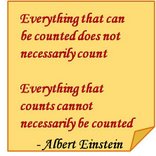I read this post on Helen's blog some days ago, that set me thinking. Is there a subconscious bias prevalent within the discipline of qual research - a bias that favors the majority such that we lay greater emphasis on the thoughts expressed by 'many' vis-a-vis those expressed by a 'few'?
There are two reasons I could think of - about why this could happen
1. An external bias (from the client)
Even though in the recent past people have begun to appreciate the kind of information that qualitative research brings to the fore - it is still, often judged by the same yardstick as is used in case of quant research. How many times have we heard clients challenge findings by asking questions like...can you tell me how many people felt that way and the researcher diffidently admitting...well, there were just a few. To which one would hear...well then lets not give it too much importance and move on...Why does this emphasis on numbers infiltrate qualitative studies as well? Is that the only metric by which the worth of something can be judged ? What makes people so easily believe that the view point expressed by 'one' or a 'few' is a not a thought worth pursuing ?
I suppose repeated exposure to this way of thinking could lead researchers to start questioning their own beliefs such that the next time one is faced with a stray thought like that - rather than sounding shaky in front of a client, the researcher may nip it in the bud.
2. The other is the researcher's own bias
For long qual researchers have relied on the technique of 'story telling' to analyse and present findings. This helps the researcher see inter-connections in the data set such that she can look at the data holistically and understand the consumer's mind set i.e. where the consumer is coming from. It is also an effective way of communicating findings to the client - to narrate the findings in a sequence that ultimately builds up to the climax i.e. the insight !
But how does one treat a piece of data that does not fit in with one's beautifully crafted story? For a long time I would keep aside that piece of data, treat it as an exception - that is what I had initially learnt - filter it out - if it does not fit in with your story. It is much later I learnt that...If it does not fit in with your story....there must be a bloody good reason for it....so look at the data again...tap it gently from either side, sleep over it and you will eventually find out WHY!
I do not believe that every stray thought that one hears would definitely hide something significant under its skin. However, don't discard it or belittle it before giving it the attention it deserves. As Helen rightly puts it...
"An inconvenient little wobble in a research context, could mean something more significant in real life. I think we have a duty to report them. Carefully."
P.S - If you are used to thinking 'the more the merrier' - think again - more does not have to mean more number of people with single thought, it could also mean a few people with more number of thoughts



